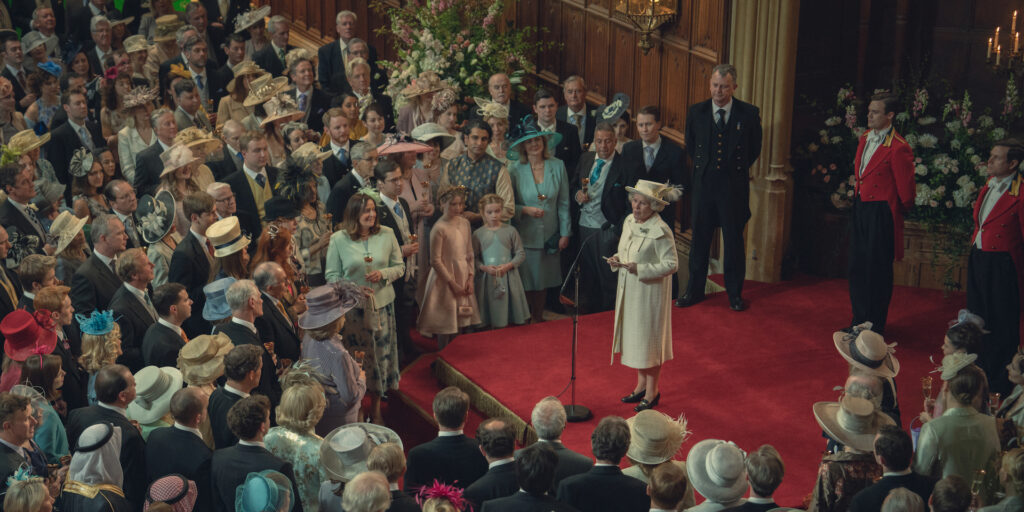Martin Childs is a British production designer, an Academy Award Winner, BAFTA Winner, and in 2002, he was appointed as a Member of the Most Excellent Order of the British Empire for his contributions to British culture. His Production Design credits include Quills, From Hell, and Shakespeare in Love.
Before that, he was a prolific art director and worked on Henry V, Much Ado About Nothing, and The Madness Of King George. Childs was recently awarded the Lifetime Achievement Award of the British Film Designers Guild, as well.
Childs has done the Production Design for every season of The Crown. The acclaimed series just recently wrapped its final season marking the end of an era with the real-life death of Queen Elizabeth II, which was documented on screen by the talented cast and crew of this celebrated series. Childs recently spoke to Immersive via Zoom.
[Note: This conversation has been edited to clarity and length.]
You have been on The Crown since the very beginning. Please, tell me a little bit about the experience of seeing this whole project through from its inception.
What attracted me to the project from the beginning was the fact that not only was I going to be working with Stephen Daldry and Peter Morgan, which was an attraction, to begin with, but also an opportunity to work on something about The Queen. The Queen came to the throne a couple of years before I was born, so I’d never known life without her until recently. It’s the first time I’ve ever been able to use personal experience and personal memory as research. That was an appealing thing, and recreating these events that I knew so well, some of which I remember distantly from my childhood.
Having spoken to several people who worked on The Crown, several departments described the Bible (or Dossier) they would get at the start of production. What’d you learn from the Bible?
I had my Show Bible. I then have to be selective about how much to recreate to the letter of the Bible because I’m telling a story. If you follow too closely in detail, then you’re going to get into some tricky situations as a designer because you’re going to find that a yellow and blue set follows a yellow and blue set and the audience won’t know where we are.
Sometimes when I’m watching movies or TV shows, I get lost. I’m like, did they go somewhere or are they in the same room? Yeah.
That was one of the key things I did. I would kind of take Peter Morgan’s script and take a piece of paper. I would do a map of the script and I would start with Buckingham Palace in the middle and spin out from it. I’d be able to connect all of the scenes and work out how these things should follow research as much as they can.
Did you have to any access to the Royal Family? Did you physically go into Buckingham Palace?
One of the great things about this show is that you can do some of your research as a tourist. I would go on a tour of Buckingham Palace, I’d go on a tour of Windsor Castle. I got to know these places quite well, and all of the palaces. I would go along and pretend to be a tourist. So that was the great luxury of this, I didn’t have to admit that I was researching a show when I visited.
Was there anything that you saw that surprised you?
Some things were kind of surprisingly homey, and I thought, if I replicate this, it’s going to look like we can’t afford to do this stuff. Long before I was doing The Crown, I went to a garden party at Buckingham Palace, and I was surprised at the normalcy of some of what I saw. I felt as if we needed to pick the Royal Family up a bit because we were telling a story about one of the wealthiest women in the world.
What were some of the unique challenges of the final season?
St. George’s Chapel at the end for Charles and Camilla’s wedding, and for the scenes between the very final scene of The Queen and the coffin and the two other Queens. That whole final scene had to take place in St. George’s Chapel at Windsor, which is impossible to shoot in and impossible to find anything that’s remotely like it.
We finished Upminster, which had the sort of scale and grandeur, but we had to build within it. Each of them took over 200 years to build, and we had very little time indeed, we had a window of a day and a half to build our bit of it. So we replicated all of our bits of St. George’s Chapel in the studio and put it on a truck, drove it 200 miles up the motorway, and installed it in York Minster Cathedral.

That is an amazing feat, was that the most you had to build?
We had to build quite a lot. There were quite a lot of things. We built some of the things that sort of go unnoticed. I don’t have the statistics in front of me, but I know that there were two and a half thousand sets over the entire show. That kind of works out to be a new set every two minutes, something like that.
You did a phenomenal job. Any favorite items or sets or anything, any favorites of this current season?
The sheer accomplishment of finding locations and shooting locations for the Diana and Dodi stories, which were kind of new to us. The Crown went off on a different track when it became suddenly much more contemporary. I would say as a designer, that there’s nothing more difficult than designing the recent past.
There are a lot of things in there that we had to kind of get right for period, but at the same time weren’t too distracting to the modern audience. Things like mobile phones, we don’t want people laughing at mobile phones like they do when they watch Wall Street, for example. But at the same time, you want to get that level of authenticity. So I was a bit of a stickler. We were all sticklers as a team for detail.
This is probably one of the most honored and watched shows in recent memory and has had such an epic finale and has been nominated for dozens of awards. What has The Crown experience been like for you looking back?
It’s been difficult. I miss it terribly, and I miss the camaraderie. I would see them all every day. We’re keeping in touch, but I’ve said this before, the hardest thing I’m finding to do is to relax. I’m constantly having to find new things to create. There are other jobs in the offering, but I itch to create more. And it’s been a fantastic privilege to do. It was a wonderful thrill to end on an episode with Stephen Daldry, who was the man who gave me the job in the first place nine years before. So that’s a thrill.

Going through your list of credits, there is some incredible work here… Quills, Henry V, The Madness of King George as Art Director… Ken Adam was the Production Designer, of one of the greatest of all time… Dr. Strangelove, The Original (and best) James Bond Films and so many others… What was he like?
I learned so much from Ken Adam. Working with Ken Adam was an astonishing privilege, watching him as the production designer. At the end of a day around about six o’clock, Ken would pour himself a glass of single malt and he’d be smoking on his cigar and he’d invite me in for a glass of single malt and a chat.
It was just one of the greatest things to be able to go and do that. It was in the days when magic markers developed all these fumes, and I used to be sort of slightly fearful of the combination of cigar, magic marker, and single malt whiskey. I expected there to be some kind of bond-like explosion, but there never was.
The Crown Seasons 1-6 are all available to stream on Netflix.





